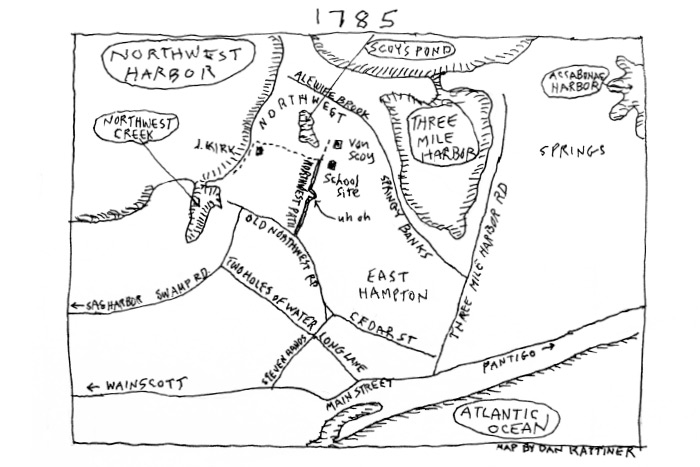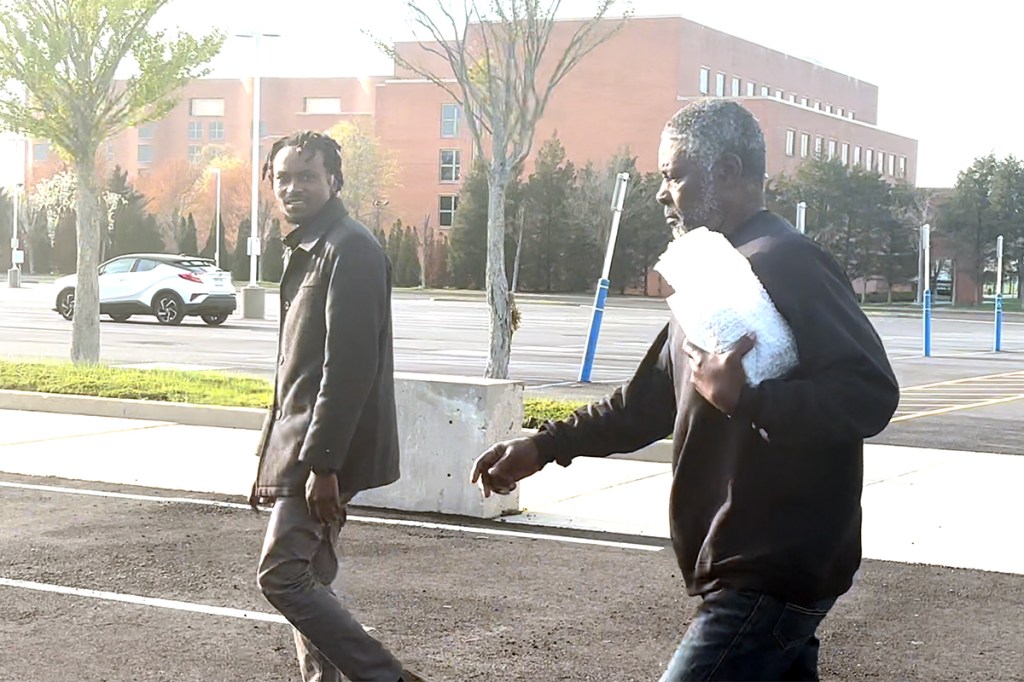What's That? The Mystery of the Sideways Maneuver on Northwest Path

If you look at a map of the Hamptons, you will see Northwest Path in East Hampton heading through deep woods. It starts at one end and goes along straight for a mile, turns suddenly to the right for a hundred yards, as if to go around something, returns to the continuation of the straight line for another mile, and then ends.
What’s in there? What would make someone alter the direction of a straight road like this to work around something? I have heard stories about it. There’s a ghost in there. Or quicksand. Or a nest of poisonous giant spiders. I decided to take the risk one day. I parked along this narrow road by this maneuver and tried walking through. But it’s so thick with underbrush, it’s virtually impenetrable. I just gave up.
But now, I think I have figured it out. It involves what the surveyors and builders were thinking when they set about making this road. And by the way, this probably happened before the American Revolution. Yes, they had surveyors then. George Washington worked as a surveyor when he was a young man in Virginia.
As many people know, back in those days there was a boat landing inside of the nearby Northwest Harbor, and a little settlement inland a half-mile. Before Long Wharf was built in Sag Harbor in 1770, ships carrying merchandise from Europe or the Caribbean to the South Fork tied up in the shallow waters of Northwest Harbor. The goods would be unloaded and taken by wagon down Old Northwest Road into downtown East Hampton, to be distributed from there. A half-mile inland from the harbor was the Northwest Settlement—to the east of the harbor, on the banks of a small freshwater pond called Scoy Pond.
Around Scoy, there are the remains of a school, a mill, two homes, some farm walls, a well, a rutted cobbled road bordered by linden trees and a cemetery. About 40 families lived there in the settlement’s heyday, and on their farms they grew fruits and vegetables, and in fenced-in areas created pasture for livestock. These farms spilled out to the west from Scoy Pond to the harbor and a curve of the beach to the northwest of the harbor. On that beach the settlement’s residents gathered seaweed. It was used as insulation for their homes.
The first schoolhouse in Northwest Settlement was built up by Scoy Pond in 1785, shortly after the Revolution. Now a new road, a direct way for people at the pond to get down to East Hampton (founded in 1648), needed to be built.
Looking at the situation, however, it became apparent that you only needed to build it halfway to town, because at that point you could link up to the earlier road to town that connected to the Harbor. The new road, connecting to the old road, is shown on an old county map, made in 1873, of East Hampton.
One imagines that the builders of the road would not begin hacking through these woods at Scoy and head south to the older road. They would build the other way around, from the old road to Scoy. It makes sense because to build a road you need equipment brought from an existing road to do the work.
Also, you would think to start building it from a point at the older road where it’s closest to Scoy. And that is indeed where they started it. They made it straight and then, halfway up, they encountered an obstruction quite suddenly and couldn’t get through, and so they made this horseshoe-shaped maneuver to get around it, and then continued straight for the remaining mile north, to end at Scoy Pond.
Had they started at Scoy Pond, the people up there might have told them about it before they began, and the road builders might have given the obstruction a wider berth. But they didn’t.
There’s a group called the East Hampton Trails Preservation Society that offers tours up into what they call the Trail to the Northwest Settlement. Since the Northwest Settlement has been abandoned, it’s easy to tell the story of its 200 years of existence, complete.
The farmland of this settlement—from harbor to Scoy Pond—was in full swing by 1680. The cattle drank from Scoy Pond, and in the winter the pond froze and the settlers cut out blocks of ice and dragged them to a nearby icehouse for use in the summertime.
After 1776, when the British invaded and captured New York and Long Island, they came ashore at Northwest Harbor on several occasions, scavenging for farm goods and livestock to feed the troops. On one occasion, they heard that a Dutchman at Scoy named Isaac Van Scoy had 50 pounds that somebody had paid him, and they came to steal it. Van Scoy would not give in. He brandished a pitchfork, stabbed one of the Redcoats to death and wounded the others. They arrested Van Scoy and took him to a prison ship, a small frigate offshore, but during the night Van Scoy’s neighbors came out in a rowboat and smuggled him back out of the ship through a small window. Van Scoy remained in hiding for the rest of the war, and was considered a war hero as a result.
His children took over the farm when he died in 1810, at the age of 83. But Northwest was in decline by then. Its harbor was too shallow to compete with Sag Harbor.
Around 1860, a nasty tempered Irishman named Josiah Kirk bought 400 acres in Northwest, including 1,000 feet on the bay. He put up fences to prevent neighbors from scavenging for seaweed on his property. Lawsuits were filed to force him to allow the neighbors to scavenge as they had done before he came, but Kirk won in court—though he spent all his money on his defense. Broke after that, he went to the poor house in Islip and died soon afterwards. But by then, Northwest Village was no longer inhabited at all.
So what did Northwest Path maneuver around? You can see it on an aerial view of the woods today. It’s oval in shape, with the foliage in this oval a different shade of green than the foliage around it. This was an impassable swamp back then. Today, if anyone tried to build a road across it, they would be able to make it through. The swamp has dried up. But why fix a charming maneuver? It’s a nice quirk in there, and something that is making the telling of this story possible.



